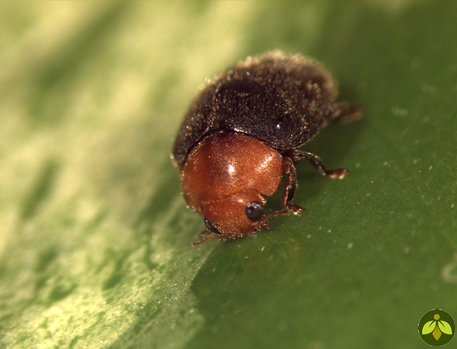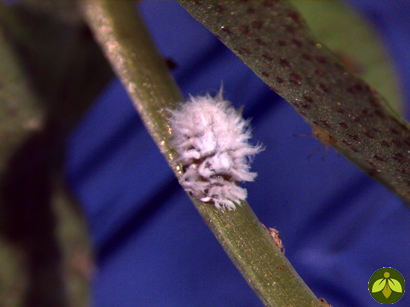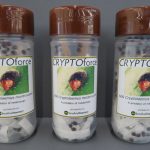Description

CRYPTOforce™ (Cryptolaemus montrouzieri), also known as “Mealybug Destroyers” and the name says it all. CRYPTOforce™, with their shiny black body and dull-orange head and thorax, definitely prefer to dine on mealybugs. They can clean up large populations. However, as most beetles are, CRYPTOforce™ is very opportunistic and will eat pests other than mealybugs: other scale insects (their crawlers or immature forms), insect eggs, etc. We do not recommend using these beetles for other pests, though. Control of other pests might not be obtainable with typical CRYPTOforce™ releases. Coincidental cross-predation should be regarded as a bonus of the application and nothing more.
CRYPTOforce™ is shipped as pre-fed, pre-mated, insectary-reared adults. Some popular prey of these beetles include: the citrus mealybug (Planococcus citri); the comstock mealybug (Pseudococcus comstocki); the obscure mealybug (Pseudococcus obscurus); the solenopsis mealybug (Phenacoccus solenopsis); the Mexican mealybug (Phenacoccus gossypii) and many other related species, even the long-tailed mealybug (Pseudococcus longispinus) can be consumed with greedy abandon, but only if it is present with another species which produce cottony egg-masses.
Life-style

The large 5 mm. Australian, adult female beetles lay their eggs in the cottony egg-masses produced by the pests — one egg per mass, usually, and up to 10 of them per day, for up to 50 days! The eggs hatch into white, shaggy-coated larvae which, to the inexperienced, look like mealybugs (a wolf in sheep’s clothing). These, too, are fierce predators, growing up to 1 cm. long and consuming 250 or so small mealybugs and their eggs (they’ll always eat the youngest first).
The life-span of these predators is roughly ~3 weeks in their immature stages, then around ~1 month as adults. The conditions for optimum performance will be between 64-91°F with a relative humidity of 70% or greater. But these are optimum conditions, and not necessarily a prerequisite of successful implementation. Please note, however, significantly cooler or warmer temperatures and humidity fluctuations may hamper reproduction and development a certain degree.
Scouting
Adult beetle presence, larval presence, reduction of pest numbers, “exploded” mealybug egg-masses. These are all signs that CRYPTOforce™ is hard at work.
Advisories
CRYPTOforce™ need to lay their eggs in the cottony egg-masses of their prey (as discussed under Description and Life-style). Since long-tailed mealybugs don’t lay eggs, but rather give live-birth, as aphids do, they provide no cottony masses in which the beetles can lay their eggs. This is not a problem if your site has more than one species (assuming the other species does produce the egg-masses). CRYPTOforce™ will eat immature long-tailed mealybugs with great joy, they just can’t reproduce on them.
A long-tailed-mealybug-only infestation can be overcome a couple of different ways:
Long-Tailed Mealybug Control Options
- You can place little bits of synthetic quilt batting (available from craft stores) amongst the long-tailed mealybug populace. (Avoid cotton balls as they may contain pesticide residues.) We’re not completely sure how well this works, but a number of folks have tried it, experimentally, and reported satisfactory results. Also, try placing white 3" x 5" index cards, halved, by groupings of the pests to lure the beetles in.
- Employ the Chrysoperla spp. (green lacewings) at the site. We’ve been told on numerous occasions that they do an excellent job. Use only the eggs or the larvae, however. Preferably the larvae. The adults will not do too well as they’ll be seeking out aphid colonies near which they can lay their eggs.
Aside from misting the site with water before releasing and doing so in the evening (sometimes not necessary in interiors), there are other things you can do to ensure the maximum number of beetles stick around. Flowering, pollen producing plants are a big plus to CRYPTOforce™.
Pollen isn’t the only thing these beetles will eat. They will also consume mealybug honeydew; they produce a lot. A honeydew substitute product may help encourage the beetles.
Ants, if present, should be controlled. They will defend mealybugs from predators and parasites to protect their honeydew/excrement food. Use barrier products or boric acid products to control the ants.
Last advisory: don’t wear white clothing when you’re releasing CRYPTOforce™. They are attracted to white and light colors and may find you irresistible. Also watch your sticky traps, if you’re using them. If you’re catching too many beetles, remove the traps from the site or set them out for only 2-3 days per week.
Usages
Where can’t they be used would a more appropriate question. We’ve seen the successful implementation of this species in just about every conceivable situation. Most with equal success.
Release Rates for CRYPTOforce
| Classification | Release Information |
|---|---|
| Light infestation | 2 to 4 per 10 sq. ft, repeat as needed |
| Heavy infestation | 10 to 12 per 10 sq. ft., repeat as needed |
| Orchards | 1,000 to 2,000 per acre |

